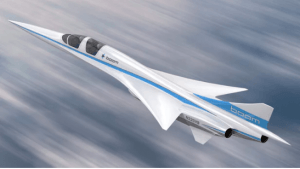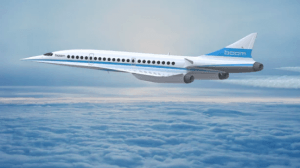
Artist’s concept of the Boom XB-1 prototype demonstrator
By David Szondy,
In news that brings hope to those who still look wistfully back to the glory days of Concorde, aviation startup Boom Technology today announced its XB-1 Supersonic Demonstrator. Nicknamed Baby Boom, the one-third scale prototype of the company’s planned Boom passenger liner is designed to test the technologies for 21st century commercial supersonic flight.
The aircraft will go on display this evening at the company’s Hangar 14 at Centennial Airport in Denver, Colorado, before an invited gathering of airline and aerospace executives and the news media. Though the XB-1 is noticeably smaller than the production aircraft, it is technically representative and shares the same distinct chine blending into the fuselage followed by the swept delta wings.
The XB-1 includes three General Electric J85-21 non-afterburning engines with proprietary variable-geometry intake and exhaust, Honeywell avionics, and carbon composite materials. Boom says the aircraft’s design is based on lessons learned from the building and operation of the Franco-British Concorde, and the design team includes veterans from NASA, SpaceX, and Boeing.

Thanks to doing away with the need for an afterburner, Boom claims the XB-1 will be more efficient than Concorde and will fly ten percent faster, with a cruising speed of Mach 2.2 (1,451 mph, 2,335 km/h) – 2.6 times faster than conventional subsonic airliners.
Designed to carry a crew of two plus an optional test flight engineer, the prototype has a wingspan of 17 ft (5 m), a takeoff weight of 13,500 lb (6,100 kg), and a range of over 1,000 nm (1,150 mi, 1,852 km). In contrast, the production Boom airliner will have a wingspan of 60 ft (18 m), carry a crew of up to six plus up to 55 passengers, and have a range of 9,000 nm (10,300 mi, 16,700 km).
Boom says the first flight of the XB-1 is slated for late next year, with subsonic flights taking off east of Denver airspace and supersonic tests to be conducted near Edwards Air Force Base, California, in conjunction with Virgin Galactic.

“I have long been passionate about aerospace innovation and the development of high-speed commercial flights,” says Sir Richard Branson, founder of Virgin Group. “As an innovator in the space, Virgin Galactic’s decision to work with Boom was an easy one. We’re excited to have an option on Boom’s first 10 air frames. Through Virgin Galactic’s manufacturing arm, The Spaceship Company, we will provide engineering and manufacturing services, along with flight test support and operations as part of our shared ambitions.”
